Sarah Sundin's Blog, page 51
June 14, 2024
Hospitalization in World War II – Evacuation of the Wounded
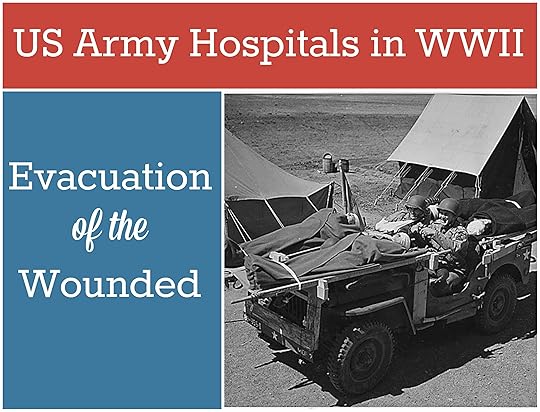
Photo: Jeep ambulance at Camp Carson, CO, 24 Apr 1943 (US National Archives: ARC 197176)
Unlike the US Fifth Army, Hutch crossed the Volturno River backward. While the Allies crossed under machine-gun fire eleven days earlier, Hutch rode in a jeep, turned in the front seat to face little Lucia. Her litter was strapped across the backseat, while two more litters were strapped on the hood.
A furrow raced up Lucia’s forehead, and she clutched her doll even tighter.
Time for Hutch’s treat. “I have a gift for you. For Lucia.” (On Distant Shores, p. 194)
In my novel On Distant Shores, the hero serves as a pharmacist in an evacuation hospital and the heroine serves as a flight nurse. This article is the second in a three-part series on US Army hospitalization in World War II.
Part 1: Chain of Evacuation
Part 2: Mobile and Fixed Hospitals
Part 3: Evacuation of the Wounded
Evacuation of the WoundedManual TransportOn the battlefield, medics or fellow soldiers could manually carry a wounded man further to the rear for aid. Methods included the supporting carry (walking side-by-side), the arms carry, the saddleback carry (piggy-back), and the fireman’s carry.
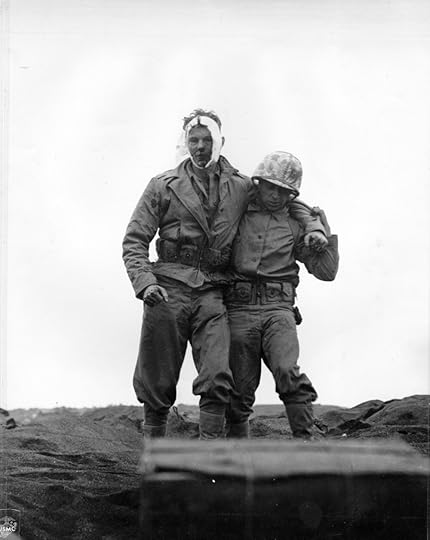
Wounded US Marine being helped by a comrade, Iwo Jima, 20 Feb 1945 (US Marine Corps photo)
Litter TransportAmerican litters were made of canvas stretched over aluminum or wood poles with stirrup-shaped feet to keep them off the ground. A litter could be carried by two people, but a litter squad consisted of four men, to rotate if traveling long distances and to assist over obstacles. Ideally, litter transport was only used for short distances, but in mountainous or forested or swampy terrain, litter transport was the only available means. Mules were often used in the Mediterranean Theater to carry litters in rocky, mountainous terrain.
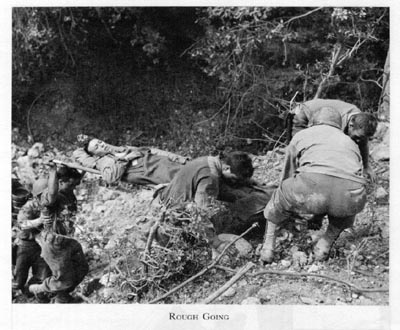
Litter-bearers in Italy’s mountains, WWII (US Army Medical Dept.)
Motor TransportAmbulances were used to transport patients, usually from an aid, clearing, or collecting station to a field hospital, or for transport further to the rear. Ambulances could carry seven seated patients or four patients on litters.
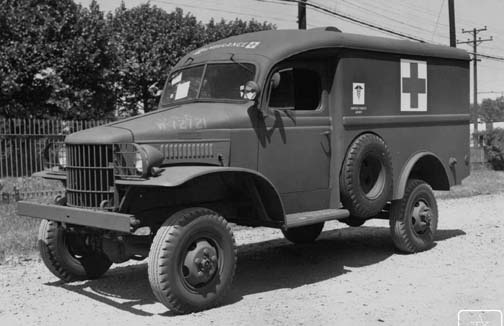
Dodge WC9 1/2 ton ambulance, 15 May 1941 (US National Archives)
Jeeps were often used, both on the battleground and to transport further to the rear. Rugged and maneuverable, jeeps could cover terrain inaccessible to ambulances. With litter brackets, a jeep could carry two or three patients. Armored divisions also used light tanks to transport their wounded.
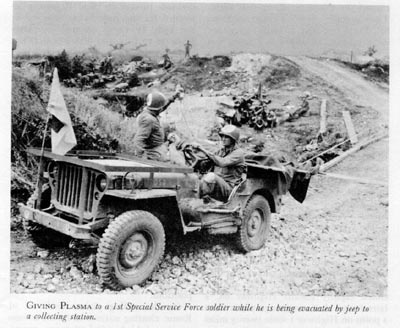
US medics administer plasma to a patient in a jeep ambulance, Italy, 1944 (US Army Medical Dept.)
Water TransportDuring an amphibious landing, the best way to handle the wounded was to send them back on departing landing craft, which carried them to transports or hospital ships off-shore. Patients could be removed from danger and transported quickly to get needed care.
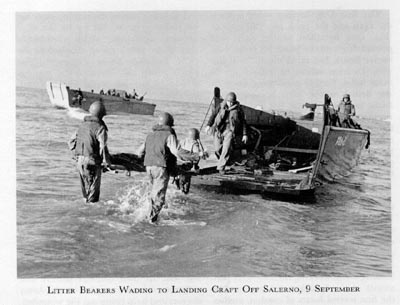
Wounded American soldiers being evacuated by landing craft (LCVP) off Salerno, Italy, 9 September 1943. (US Army Medical Dept.)
Hospital ships were used offshore after an invasion to care for the wounded before field and evacuation hospitals could be set up. They also transported patients who needed long-term care to general hospitals further to the rear. Another use of hospital ships was to transport to the US any patients who needed long-term convalescent care or those who qualified for a medical discharge. They carried several hundred patients and delivered full medical care, but transport took a long time and carried the danger of enemy attack at sea, even when marked with the Red Cross.
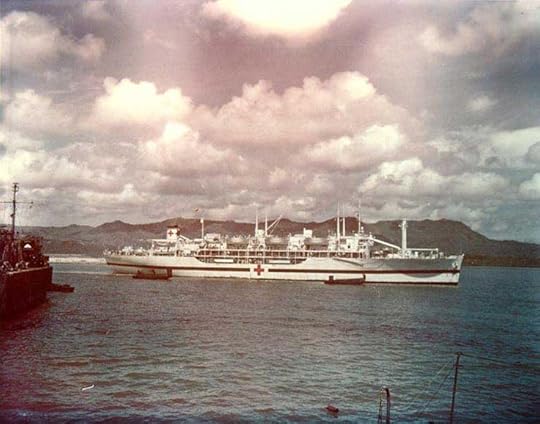
Hospital ship USS Tranquility arriving at Guam with survivors of sinking of USS Indianapolis, 8 Aug 1945. (US National Archives: 80-G-K-5979)
Rail TransportHospital trains were used within theaters of operation to transport patients from one hospital to another. They were used in the continental US, Britain, continental Europe, India, and North Africa. They could carry several hundred patients and provide excellent medical care.
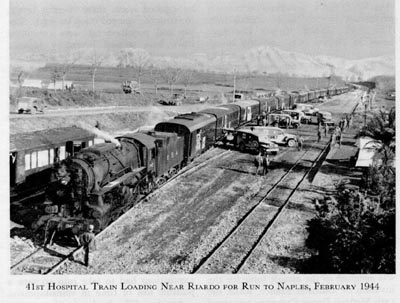
US 41st Hospital Train running from the Italian front to the Army hospital complex in Naples, February 1944 (US Army Medical Dept.)
Air TransportMedical air evacuation was new and revolutionary, but by the end of the war, it proved successful. Planes can traverse inhospitable terrain or dangerous seas—and quickly. C-47 cargo planes carried 18-24 litter patients or a higher number of ambulatory patients. A team consisting of a flight nurse and a surgical technician cared for the patients in flight. The larger C-54 cargo plane was used for trans-oceanic evacuation. Danger still existed, both from the inherent risks of flight and also because the planes carried cargo, couldn’t be marked with the Red Cross, and were legitimate military targets.
Read more in my blog series: Medical Air Evacuation in World War II.
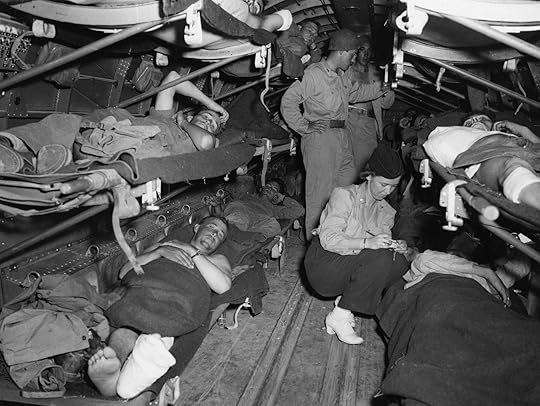
Lt. Katye Swope of the 802nd Medical Air Evacuation Transport Squadron checks patients being evacuated from Agrigento, Sicily to North Africa for further medical treatment, 25 July 1943 (US Air Force photo 25749AC)
ResourcesOffice of the Surgeon General. Medical Field Manual: Transportation of the Sick and Wounded. Washington, DC: US Government Printing Office, Feb. 21, 1941. Please note the date—some of the material, especially about air evacuation, became quickly outdated.
For better information on air evacuation, please see:
Links, Mae Mills & Coleman, Hubert A. Medical Support of the Army Air Forces in World War II. Washington, D.C.: Office of the Surgeon General, USAF, 1955.
The post Hospitalization in World War II – Evacuation of the Wounded first appeared on Sarah Sundin.Today in World War II History—June 14, 1944
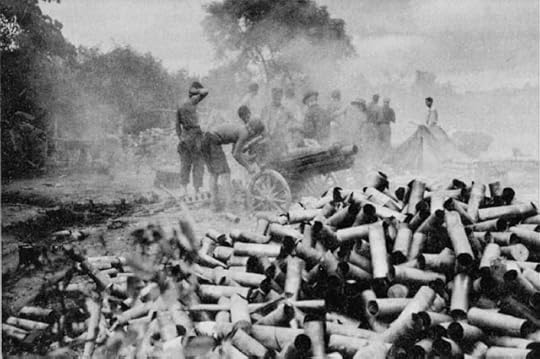
US 75-mm howitzer crew firing at Japanese positions in Myitkyina, Burma, June 1944 (US Army Center of Military History)
80 Years Ago—June 14, 1944: US and Chinese troops attack besieged Japanese forces in Myitkyina, Burma.
At night, an RAF Mosquito becomes the first aircraft to shoot down a German V-1 buzz bomb.
Australia begins meat rationing (2 pounds per week).
The post Today in World War II History—June 14, 1944 first appeared on Sarah Sundin.June 13, 2024
Hospitalization in World War II – Mobile and Fixed Hospitals
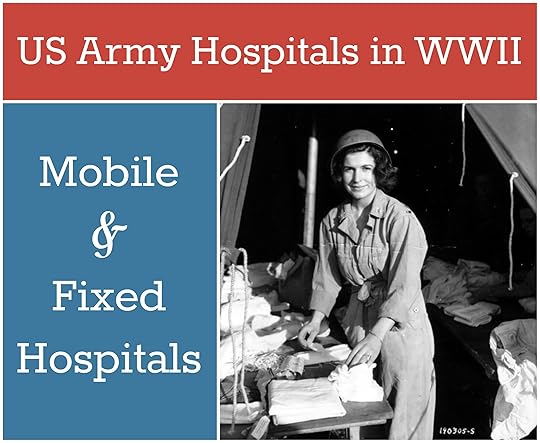
Photo: US Army nurse preparing dressings, 15 June 1944, 13th Field Hospital, St.-Laurent-sur-Mer, Normandy (US National Archives: 190305-S)
Hutch crossed his arms over his soggy mackinaw and gave Bergie half a smile. “You said you’d take over. Ever pitch a tent before?”
“In Boy Scouts.” The surgeon raised a three-finger salute. “On my honor–“
“A big old Army ward tent?”
“Nope. But I’m willing to get dirty. What’s mud compared to the blood and guts I usually swim in?”
Hutch turned to Sergeant Paskun. “I’ll put the captain on my team and mess up his pretty officer’s manicure.”
“Heavens to Betsy!” Bergie said in a falsetto, inspecting his fingernails. “I just had them done.” (On Distant Shores, p. 150)
In my novel On Distant Shores, the hero serves as a pharmacist in an evacuation hospital and the heroine serves as a flight nurse. This article is the second in a three-part series on US Army hospitalization in World War II.
Part 1: Chain of Evacuation
Part 2: Mobile and Fixed Hospitals
Part 3: Evacuation of the Wounded
Mobile HospitalsField hospitals (400 beds) and evacuation hospitals (400 or 750 beds) arrived within a few days of an invasion and followed the army, staying about thirty miles behind the front. They were close enough to treat patients quickly and send them back to the front quickly as well.
These hospitals relied on mobility. They usually used canvas tents, but also used schools, barracks, hospital buildings, hotels, Mediterranean villas, and even an Italian stadium. A few days before a move, the hospital stopped admitting patients and evacuated their current patients to other hospitals. They packed their equipment and personnel into trucks, advanced to the next location, set up, and were ready to admit patients within hours.
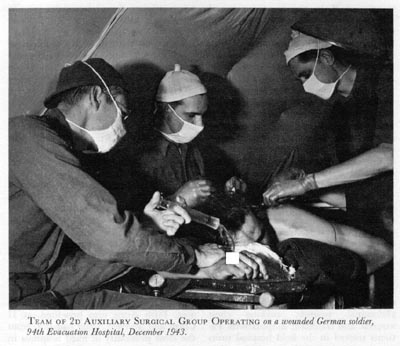
Surgeons at 94th Evacuation Hospital, Italy, December 1943 (US Army Medical Dept.)
When ambulances arrived, triage officers sent patients to pre-op, medical, shock, or evacuation wards as needed. Surgical teams worked twelve hours on, then twelve hours off.
In the European Theater (England, France, Belgium, Germany), the field hospitals stayed closer to the front, with the evacuation hospitals farther to the rear. In the Mediterranean Theater (North Africa, Sicily, Italy, southern France), field hospitals and evacuation hospitals were used interchangeably. Both theaters practiced “leapfrogging” as the front advanced—hospital A would pass hospital B, then hospital B would pass hospital A. This reduced the frequency of moves
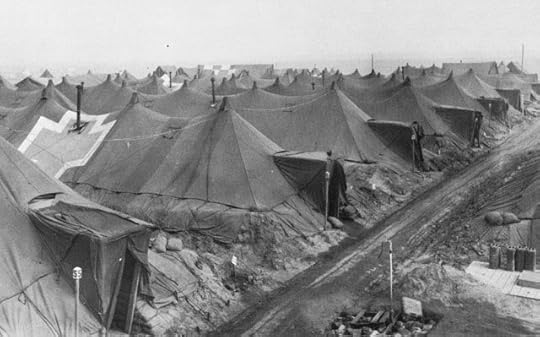
US evacuation hospital tents on the Anzio beachhead, Italy, spring 1944, revetted for protection from bombs and shells (US Army Medical Dept.)
Fixed Hospitals
The station hospitals (250, 500, or 750 beds), general hospitals (1000 beds), and convalescent hospitals (2000 or 3000 beds) were set up far from the front to keep patients safe from danger, but also to keep them in the theater, which made it easier to return the soldiers to duty. In England before D-day, field and evacuation hospitals waiting for the Normandy invasion functioned as station hospitals to care for patients.
In each theater of operations, fixed hospitals operated in what was called the “Communications Zone.” In the European Theater, the COMZ was originally in England, then as the Allies approached the German border, the COMZ extended to include Normandy and Belgium. In the Mediterranean Theater, Morocco served as the first COMZ, then Algeria. When the Allies invaded Sicily and Italy, North Africa was the COMZ, and as the front advanced, the COMZ was established in the Naples area of southern Italy. In the Pacific, fixed hospitals were first established in Hawaii and Australia, then followed into secured regions.
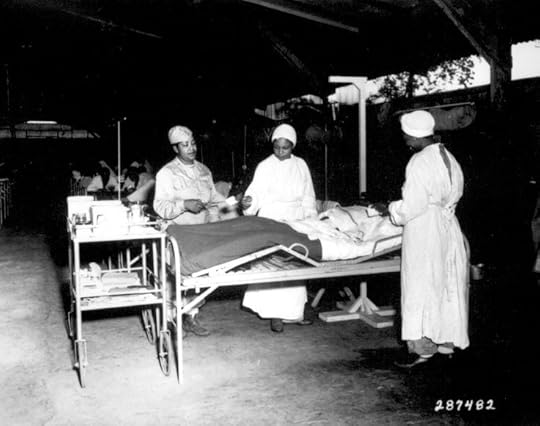
African-American US Army nurses Lt Prudence Burns, Lt Elcena Townscent, and a 3rd nurse treating Sgt Lawrence McKreever, 268th Station Hospital, Milne Bay, New Guinea, 22 Jun 1944 (US National Archives: 111-SC-28748)
Fixed hospitals moved less often and occupied more permanent facilities. American units used some standing hospitals in host or occupied countries, but many were a collection of tents or Nissen huts, 20-ft by 40-ft corrugated tin semi-cylinders. In England, Nissen-hut hospital complexes were often placed on estate grounds, and had concrete floors, flush toilets, clean water, and were heated by coal-burning stoves. In the Mediterranean and Pacific, facilities were more primitive but improved over time. In these theaters, mosquito netting was draped over the beds to prevent transmission of malaria.
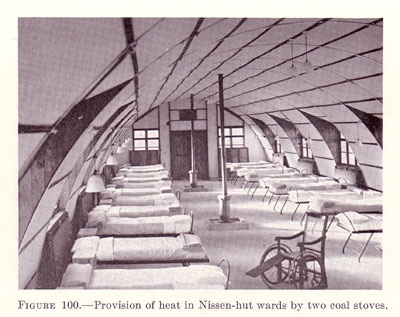
Nissen-hut hospital in England. Note coal stoves in center (US Army Medical Dept.)
Fixed hospitals in the Zone of the Interior (continental United States) enjoyed the benefits of modern buildings and facilities. However, shortages of medication, equipment, and personnel were always a problem.
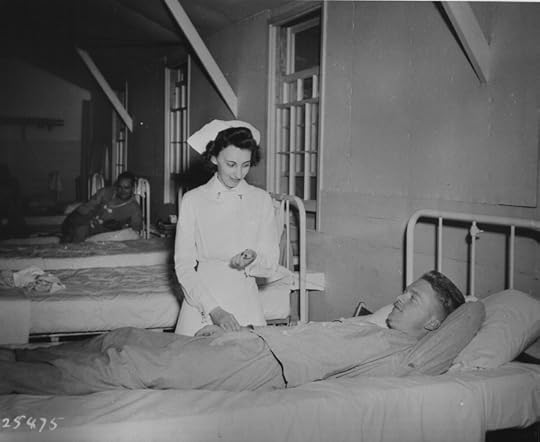
Army nurse attending patient, Camp Forrest, Tullahoma, TN, 22 Sept. 1941 (US Army Medical Dept.)
ResourcesCosmas, Graham A. & Cowdrey, Albert E. The Medical Department: Medical Service in the European Theater of Operations. Washington, D.C.: United States Army Center of Medical History, 1992.
Wiltse, Charles M. The Medical Department: Medical Services in the Mediterranean and Minor Theaters. Washington, DC: Office of the Chief of Military History, Department of the Army, 1965.
Condon-Rall, MaryEllen & Cowdrey, Albert E. The Medical Department: Medical Service in the War Against Japan. Washington, D.C.: United States Army Center of Medical History, 1998.
Links, Mae Mills & Coleman, Hubert A. Medical Support of the Army Air Forces in World War II. Washington, D.C.: Office of the Surgeon General, USAF, 1955.
Smith, Clarence McKittrick. The Medical Department: Hospitalization and Evacuation, Zone of the Interior. Washington, DC: Center of Military History, United States Army, 1989.
The post Hospitalization in World War II – Mobile and Fixed Hospitals first appeared on Sarah Sundin.Today in World War II History—June 13, 1944
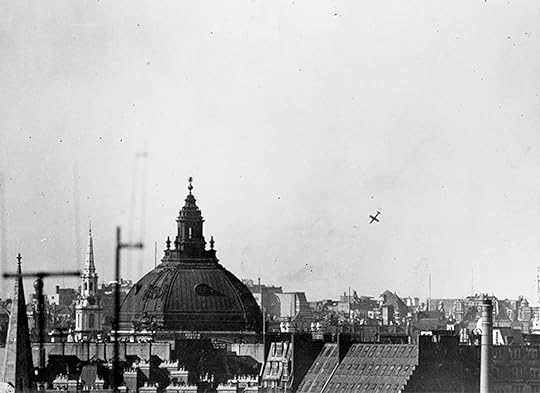
V-1 “buzz bomb” falling over Covent Garden area of London, 14 June 1944 (US Air Force: 090928-F-1234S-009)
80 Years Ago—June 13, 1944: Germans launch first V-1 buzz bomb at London; 7,000 will be launched by Aug. 24, killing almost 5,000.
At Villers-Bocage in Normandy, one German Tiger tank destroys 25 British tanks.
The post Today in World War II History—June 13, 1944 first appeared on Sarah Sundin.June 12, 2024
Hospitalization in World War II – Chain of Evacuation
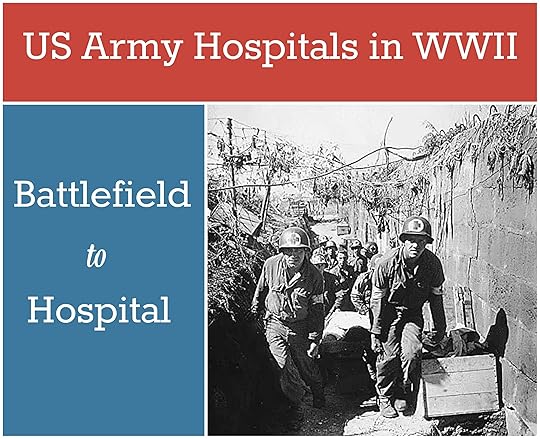
Photo: US Army medics removing a casualty from the battlefield to an aid station in an air shelter, near Brest, France, 28 Aug 1944 (US National Archives: ARC 531320)
Planes thundered overhead, artillery rumbled in the distance, and cries of wounded soldiers pierced Georgie’s ears.
“Coming through.” Two medics rushed past with a litter. A man writhed on top, a shock of red on his gray-green field jacket. Another medic assisted a soldier who clutched his twisted, bloodstained arm to his chest.
Georgie took a deep breath. Compared to the ravages of battle, her concerns were nitpicky. (On Distant Shores, p. 118)
In my novel On Distant Shores, the hero serves as a pharmacist in a US Army evacuation hospital and the heroine serves as a flight nurse. This article is the first in a three-part series on US Army hospitalization in World War II:
Part 1: Chain of Evacuation
Part 2: Mobile and Fixed Hospitals
Part 3: Evacuation of the Wounded
The Chain of Evacuation
In the US Army in World War II, medical treatment occurred on muddy battlefields under fire, in tent hospitals only miles from the front, and in sterile stateside hospitals.
A complex chain moved patients to where they could best be treated. At all points along this chain, decisions were made regarding when to treat, when to return to duty, and when to evacuate further to the rear.
Organic Medical UnitsThese units were attached to combat units and followed them into battle.
Battlefield:Medics performed first aid and moved the wounded to the aid station, often under fire.
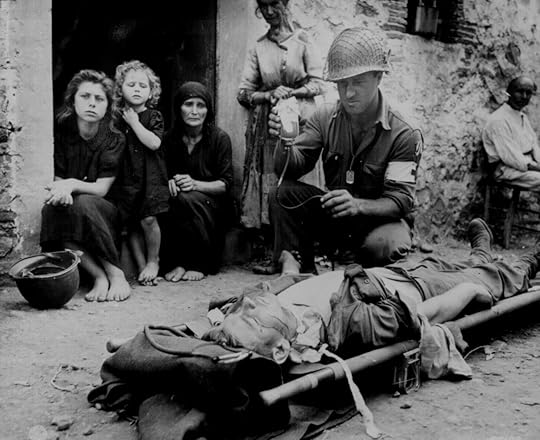
US Army medic administering plasma to wounded Private Roy Humphrey, Sant’Agata, Sicily, Italy, 9 Aug 1943 (US National Archives: 111-SC-178198)
Battalion Aid Station:About one mile from front. Physicians and medics adjusted splints and dressings, and they administered plasma and morphine. Soldiers also reported to the aid station for treatment of minor illnesses or mild combat fatigue.
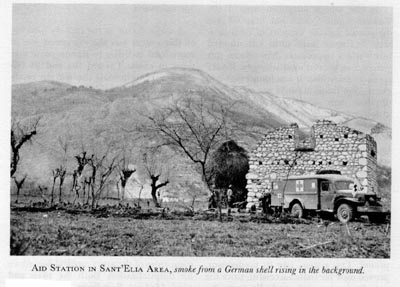
US Army forward aid station in Sant’Elia, Italy, 1943 (US Army Medical Dept)
Collecting Station:About two miles from the front, near the regiment command post. Further adjustment of splints and dressings, administration of plasma, and treatment of shock.
Clearing Station:About four to ten miles from the front. Here they treated shock and minor wounds, and grouped patients in ambulance loads for transport to field hospitals.
Mobile HospitalsThese hospitals were assigned to a theater of operations and could be packed and moved quickly to follow the battle lines. They were complete hospitals with nursing care, surgical and medical wards, X-ray, laboratory, and pharmacy.
Field Hospitals:Within thirty miles of clearing station. Ideally, the wounded arrived within one hour of injury. Surgery was performed for the most severe cases.
Evacuation Hospitals:Treated illnesses and less urgent surgical cases. Patients could be reconditioned here to return to the front.
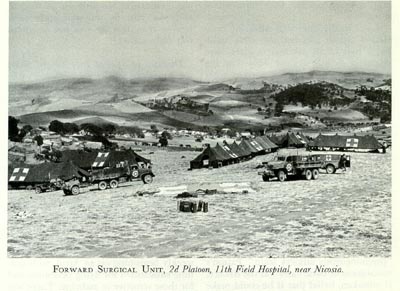
Forward surgical unit, US 11th Field Hospital near Nicosia, Sicily, 1943 (US Army Medical Dept)
Fixed HospitalsThese hospitals were set up a safe distance from the front, either in the theater of operations or stateside, and they tended to remain in one location for longer periods of time.
Station Hospitals:Usually attached to a military base, designed to treat illnesses and injuries among personnel stationed at that base.
General Hospitals:Large facilities where patients received long-term treatment, sometimes grouped in large complexes. Some of the general hospitals were specialized for certain types of wounds or illnesses, such as for craniocerebral, spine, eye, chest, or neuropsychiatric care.
Convalescent Hospitals:Designed for rehabilitation of the severely wounded soldier who would receive a medical discharge. This type of hospital was a World War II innovation.
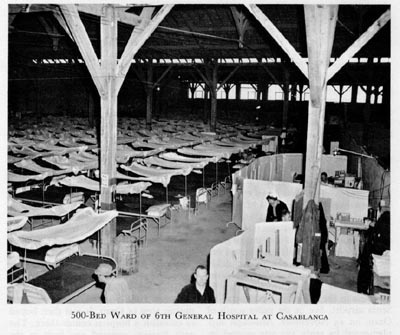
500-bed ward of US 6th General Hospital, Casablanca, French Morocco, 1943 (US Army Medical Dept)
ResourcesCosmas, Graham A. & Cowdrey, Albert E. The Medical Department: Medical Service in the European Theater of Operations. Washington, D.C.: United States Army Center of Medical History, 1992.
Wiltse, Charles M. The Medical Department: Medical Services in the Mediterranean and Minor Theaters. Washington, DC: Office of the Chief of Military History, Department of the Army, 1965.
Condon-Rall, MaryEllen & Cowdrey, Albert E. The Medical Department: Medical Service in the War Against Japan. Washington, D.C.: United States Army Center of Medical History, 1998.
Links, Mae Mills & Coleman, Hubert A. Medical Support of the Army Air Forces in World War II. Washington, D.C.: Office of the Surgeon General, USAF, 1955.
The post Hospitalization in World War II – Chain of Evacuation first appeared on Sarah Sundin.Today in World War II History—June 12, 1944
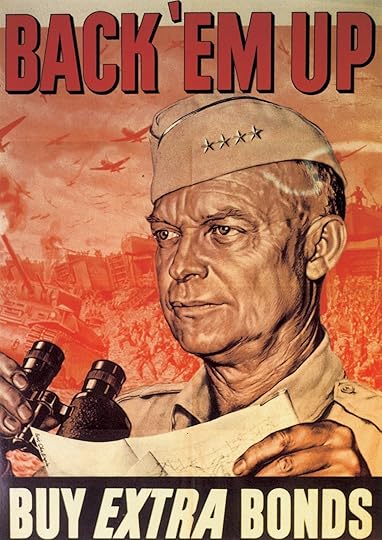
US war bond poster, 1944
80 Years Ago—June 12, 1944: Allies consolidate all five landing beaches in Normandy, a 50-mile front, as US forces from Omaha and Utah Beaches link near Carentan.
US Fifth War Loan starts, launched with a broadcast by President Franklin Roosevelt in his final Fireside Chat. (Read more: “World War II War Bonds”)
Big Bend National Park is established in Texas.
The post Today in World War II History—June 12, 1944 first appeared on Sarah Sundin.June 11, 2024
Today in World War II History—June 11, 1944
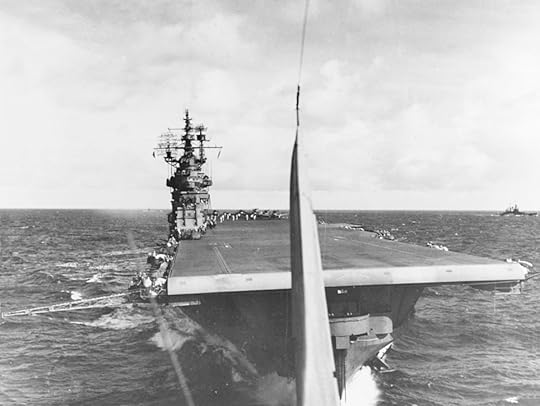
SBD Dauntless after taking off from the carrier USS Lexington for strikes against Saipan in the Mariana Islands, 13 Jun 1944 (US Naval History and Heritage Command: 80-G-236932)
80 Years Ago—June 11, 1944: US Fast Carrier Attack Force (TF 58) with 15 aircraft carriers begins bombing the Mariana Islands in preparation for invasion.
Battleship USS Missouri is commissioned at Brooklyn, NY, the last battleship in the US Navy, currently a museum ship at Pearl Harbor. (See photos from my tour of the USS Missouri at Pearl Harbor).
Dutch resistance group LKP raids a prison in Arnhem and frees 54 prisoners without firing a shot.
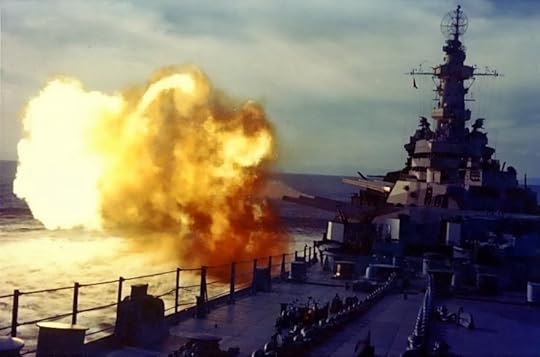
USS Missouri firing a salvo in her shakedown period, August 1944 (US National Archives: 80-G-K-4546)
The post Today in World War II History—June 11, 1944 first appeared on Sarah Sundin.June 10, 2024
Today in World War II History—June 10, 1944
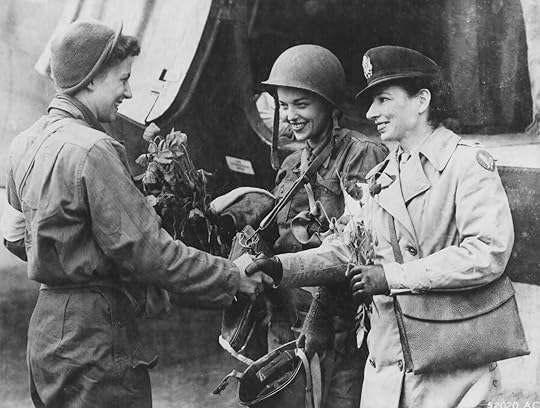
Flight nurses Lt. Suella Bernard and Lt. Marijean Brown, the first nurses to evacuate the wounded from Normandy to England, are greeted by their head nurse, Lt. Foster. (US Air Force photo: AC 52020)
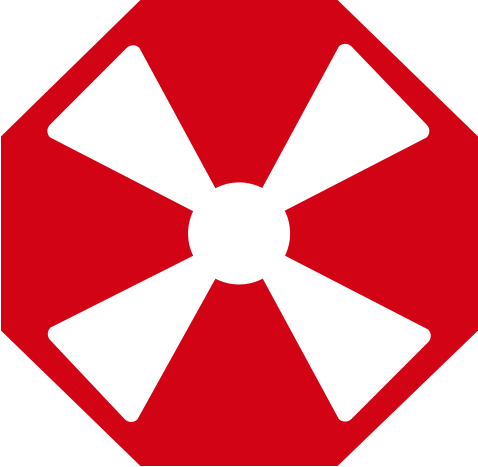
Patch of the US Eighth Army, WWII
80 Years Ago—June 10, 1944: German SS troops massacre 642 civilians in Oradour-sur-Glane, France; only 10 survive.
US Eighth Army is activated at Memphis, TN, under Lt. Gen. Robert Eichelberger (will serve in the Pacific).
First US nurses and female American Red Cross workers land in Normandy, with the 128th Evacuation Hospital.
US flight nurses fly first medical air evacuation missions from France to England. (Read more about flight nurses: “Medical Air Evacuation in World War II – The Flight Nurse”)
At age 15, Joe Nuxhall with the Cincinnati Reds becomes the youngest player ever in Major League Baseball.
The post Today in World War II History—June 10, 1944 first appeared on Sarah Sundin.June 9, 2024
Today in World War II History—June 9, 1944
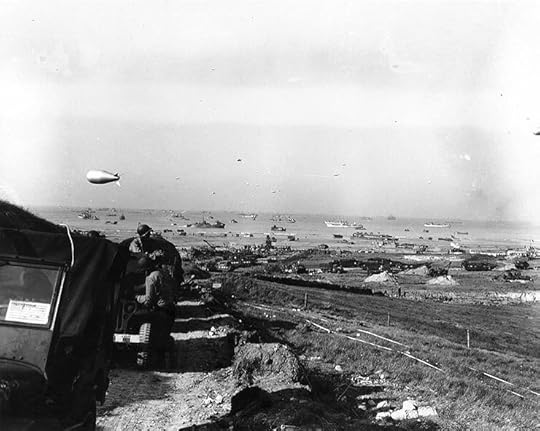
US troops and equipment being landed near Colleville-sur-Mer, France, 9 Jun 1944 (US National Archives: SC 190058)
80 Years Ago—June 9, 1944: Allies deliberately sink 53 old ships off Normandy to serve as breakwaters.
RAF flies from French airfields for the first time since 1940.
Soviets launch an offensive on the Karelian Isthmus to take land lost to Finland in 1941.
The post Today in World War II History—June 9, 1944 first appeared on Sarah Sundin.June 8, 2024
Today in World War II History—June 8, 1944
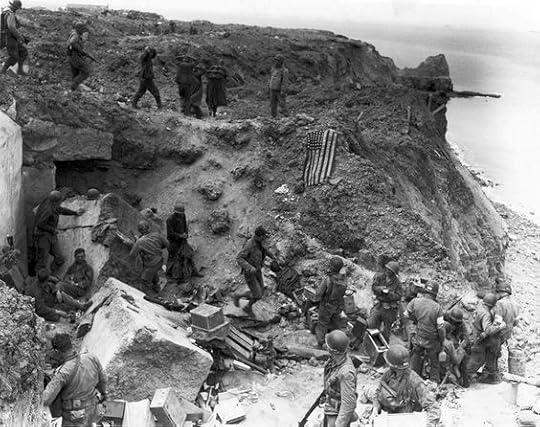
US 2nd Ranger Battalion at Pointe du Hoc after relief on D+2 (June 8, 1944); American flag had been spread out to stop fire of friendly tanks coming from inland. Some German prisoners are being moved after capture (US Army Signal Corps photo: SC190240)
80 Years Ago—June 8, 1944: In Normandy, British and US forces link near Port-en-Bessin.
The US 2nd Ranger Battalion at Pointe du Hoc is relieved by forces from Omaha Beach. (Read more: Tour of Pointe du Hoc Part 1 and Part 2)
RAF first uses the 12,000-lb “Tallboy” bomb, destroying a train tunnel in Saumur, France, on the only north-south rail line in the Loire Valley, impeding German reinforcement of Normandy.
On the Adriatic coast of Italy, the British advance after finding the Germans have retreated.
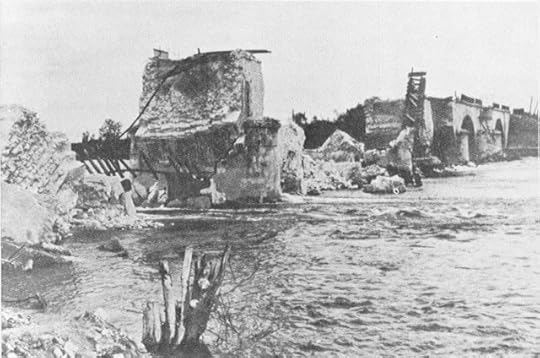
Bridge over Loire River at Saumur, France (US Air Force photo)
The post Today in World War II History—June 8, 1944 first appeared on Sarah Sundin.


